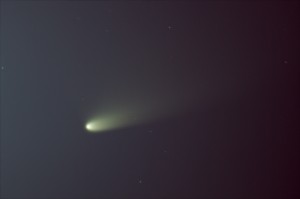El cometa C/2011 L4 Panstarrs ha cumplido con parte de las expectativas y se ha convertido en protagonista de los cielos boreales durante el mes de marzo. Desafortunadamente hemos tenido muy pocas oportunidades para observarlo debido a las continuas borrascas que han cruzado la Península Ibérica durante las últimas semanas pero hace unos días pudimos verlo y fotografiarlo con la cámara y esta semana por fin pude observarlo y fotografiarlo con telescopio. El núcleo del cometa se mostraba muy brillante y la coma era muy apreciable. La cola del cometa era de un blanco translúcido, similar a un velo de seda. Sin duda uno de los cometas más bonitos que he visto después del Hale Bopp y el Hyakutake.
Para el procesado he apilado las imágenes con Deep Sky Stacker utilizando el método de procesado de cometas y fondo de estrellas. Las tomas son solo de 4″ de exposición ya que aún había luz crepuscular y no quería que aparecieran trazas de estrellas en el procesado.
TELESCOPIO / TELESCOPE: Celestron Newton 150/750
CÁMARA / CAMERA: Canon EOS 1000D
ACCESORIOS / ACCESSORIES:
AUTOGUIADO / AUTOGUIDE:
EXP: 40×4″ (Darks y offsets)
MALE: 3/5
SEEING: 4/5 (8ºC, atmósfera en calma / wind calm)
FECHA Y LUGAR / PLACE AND DATE: 20 de marzo de 2013, Torrejón de la Calzada, Madrid
PROCESADO / PROCESSING: DSS, PixInsight LE, Photoshop
Comet C/2011 L4 Panstarrs has partially fulfilled expectations and has become a special object in the boreal skies during March. Unfortunately we had very few opportunities to observe it due to continuous clouds and rains that have crossed the Iberian Peninsula during the last weeks but a few days ago we could see and photograph with the camera, and this week I was finally able to observe and photograph it with my telescope. The nucleus of the comet was very bright and had a very noticeable coma. The tail of the comet was a translucent white, like a silk veil. Without doubt one of the most beautiful comets that I’ve seen after Hale Bopp and Hyakutake.
To process the images I stacked with Deep Sky Stacker using the processing method of comets and stars . The pictures are only 4 » of exposure because it was still twilight and did not want to appear traces of stars in the processing.


